Discover the Best Beaches in Malta and Gozo: A Guide for Sunseekers
Last Updated: Jan 26, 2024
Reading Time: 16 minutes
By: Shaun
Are you dreaming of a beach vacation in the Mediterranean? Do you want to soak up the sun, swim in the sea, and enjoy the scenery? If so, you should consider visiting the Maltese Islands, an archipelago that boasts some of the most beautiful beaches in the region.
One of the main attractions of the Maltese islands is their coastline, which spans over 250 km and features a variety of beaches. Whether you’re looking for sandy beaches or rocky beaches, you’ll find something to suit your taste and mood.
But with so many options, how do you choose the best beaches in Malta, Gozo, or Comino? Well, that depends on what you’re looking for. Some beaches are ideal for families, while others are for adventure seekers.
To help you decide, we’ve compiled a list of the best beaches across the islands. We’ve included some pros and cons for each, as well as some tips and recommendations for planning your beach holiday in Malta.
So, grab your sunscreen, sunglasses, and swimsuit, and get ready to discover the best beaches in Maltese islands.
Mellieħa Bay

Mellieħa Bay | Image by Mboesch on Wikimedia Commons
Mellieħa Bay, also known as Għadira in Maltese (meaning “the puddle”), is the largest and most popular sandy beach in Malta. It is located on the northwestern coast of the island, near the town of Mellieħa. It stretches for about 800 metres and has a shallow and gentle slope, making it ideal for families with children and beginners in water sports.
Mellieħa Bay offers a range of activities, facilities, and attractions for visitors. You can swim, sunbathe, play, or relax on the soft sand, or rent a sunbed and umbrella for more comfort. You can also try various water sports, such as windsurfing, kitesurfing, kayaking, paddle boarding, or jet skiing, or join a boat trip to nearby islands, such as Comino and Gozo. You can also enjoy the views of the surrounding hills and cliffs. You can also take a break from the sea and visit the Red Tower visible at the top of the hill, looking north, or the nearby nature reserve.
Mellieħa Bay has several pros and cons for visitors. On the plus side, it is easy to access by car or bus and has ample parking, public toilets, showers, changing rooms, lifeguards, and first aid facilities. It also has a variety of restaurants, bars, cafes, shops, and hotels nearby, catering to different budgets and preferences. On the downside, it can get very crowded and noisy, especially in the peak season. The water quality can vary depending on the weather and the currents, and it is quite far from the main attractions of the island, which are more located in the central part of the island.
Armier and Little Armier

Sunset at Armier | Image by Luca Bugeja on Wikimedia Commons
Further up north than Mellieħa Bay, one can visit Armier and Little Armier, which are two adjacent sandy beaches located on the northernmost tip of Malta. They are smaller and quieter than Mellieħa Bay, but offer similar views of the sea and the islands of Comino and Gozo. They are separated by a rocky outcrop, which also provides some shade and shelter from the wind.
Armier and Little Armier are suitable for visitors who want a more relaxed and laid-back beach experience.
The bays have some basic facilities, such as public toilets, showers, lifeguards, and first aid, and limited eating options. It is also harder to access by public transport and has limited parking space, but it is a good spot to escape the masses that visit Mellieħa Bay in the summer.
Paradise Bay

Paradise Bay | Image by Karen Bryan on Flickr
Staying up north, Paradise Bay is a small and secluded sandy beach located near the ferry terminal to Gozo. It is surrounded by cliffs and rocks, which create a natural bay and a stunning backdrop. It has a narrow and steep entrance, which requires walking down some steps, but the effort is well worth it.
Paradise Bay is perfect for visitors who want a more adventurous and scenic beach experience, but it still provides all the basic facilities found on other beaches. Although it is mostly sandy, it is surrounded by caves and rocky coves, which make this beach great for snorkelling as well. Do keep in mind that you would need to venture outside the safety of the jellyfish nets to get to the caves.
Paradise Bay can also be a great base to explore one of the most diverse and rich diving sites in Malta.
Blue Lagoon

Blue Lagoon
From the area of Marfa, close to Armier and Paradise Bay, one can take a ferry to Comino to visit the Blue Lagoon, which is known to have some of the clearest water you’ll find anywhere.
The beach is actually in the narrow body of water between the Comino and Cominetto islands. As the water flows through this channel, it can create quite strong currents, so do not venture too far out if you are not a strong swimmer.
While the Blue Lagoon does have a small sandy beach, this gets crowded fairly easily, and in the summer, the beach and the surrounding rocks can be jam-packed with people.
Santa Maria Bay
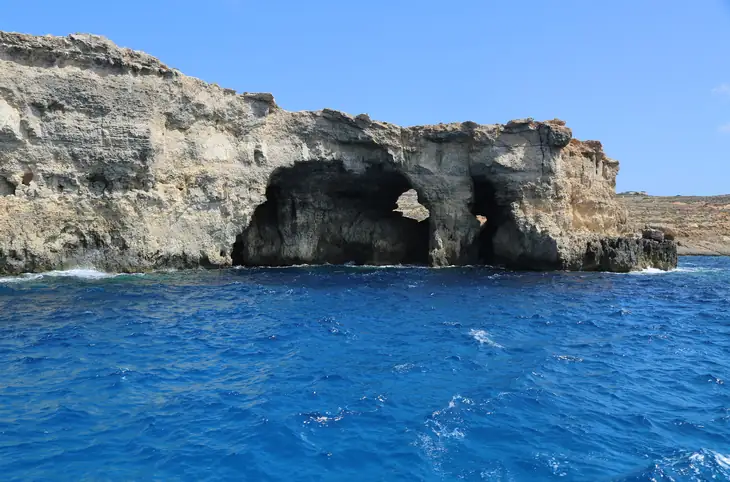
Santa Maria Caves | Image by Mick Long on Flickr
If the Blue Lagoon is too crowded and a 20-minute walk in the hot sun is not much of a problem, then you can walk to the other side of Comino to Santa Maria Bay. During the summer months, you can also find Jeep shuttles that take you to and from the beach. Once you get there, you can rent a sunbed and grab a bite or a drink from the eatery on site. From the beach, you can also catch a boat and visit the stunning Santa Maria caves.
Santa Maria Bay might not be as stunning as Blue Lagoon, but it is still a great beach in its own right.
Għajn Tuffieħa

Steps down to Għajn Tuffieħa | Image by Freddyolsson on Wikimedia Commons
Back to the main island of Malta and moving down the west coast, we now explore Għajn Tuffieħa, which is also known as Riviera Bay. Għajn Tuffieħa translates to “Apple’s Stream” in Maltese and the sand is characterised by its reddish hue. It is also more secluded than the other beaches, as it requires walking down some steps to reach it.
Għajn Tuffieħa offers a range of activities, facilities, and attractions for visitors. You can swim, sunbathe, or relax on the sand, or rent a sunbed and umbrella for more comfort. You can also try various water sports or just enjoy the views of the sea and the cliffs. One can also pay a visit to the nearby Majjistral Nature and History Park, which is the largest natural park in Malta.
Golden Bay
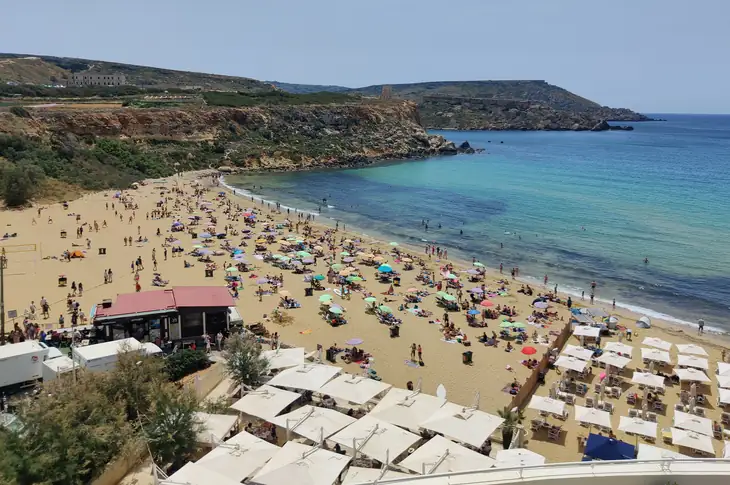
View of Golden Bay View from the Radisson Blu Resort & Spa
Adjacent to Għajn Tuffieħa, one can visit Golden Bay. This beach is wider and flatter, and it is more developed and accessible than Għajn Tuffieħa. It has a golden hue and a moderate slope, making it suitable for swimmers of all levels.
Golden Bay too offers a range of activities and facilities and is home to the Radisson Blu Resort Golden Sands, which is one of Malta’s best hotels. If 5-star hotels are too expensive for you, you can camp at the nearby camp site run by the Malta Scouts Association.
Golden Bay is a great family-friendly beach you can visit while exploring the western side of Malta.
Ġnejna Bay

Ġnejna Bay | Image by Frank Vincentz on Wikimedia Commons
Finishing off the trifacta of beaches in the area is Ġnejna Bay, which is a small and charming sandy beach located south of both Għajn Tuffieħa and Golden Bay. Just like the two beaches above, Ġnejna Bay is accessible through the transportation facilities serving the nearby town of Mġarr. It is close to Għajn Tuffieħa, but has a more secluded and rural setting, as it is surrounded by hills and fields.
It too has a gentle slope into the deeper waters, making it suitable for swimmers of all levels.
Għar Lapsi

Għar Lapsi | Image by Kritzolina on Wikimedia Commons
The west coast of Malta. might be well known for the above three sandy beaches, but just as popular with the locals is the rocky beach of Għar Lapsi. Located near the town of Siġġiewi, it is a natural inlet carved by the sea, which creates a sheltered and calm pool. It has deep and clear water, making it suitable for adventurous swimmers and a great spot for divers as well.
On the site, one can find a few restaurants, a playing field, and a parking area, making this beach easily accessible by car, but we warned that the beach is not in a cove, so if the currents are strong, do not attempt to swim in the area.
Pretty Bay

Pretty Bay, Birżebbuġa | Image by Frank Vincentz on Wikimedia Commons
Moving to the south of Malta, the largest beach in this area is Pretty Bay, in the heart of the town of Birżebbuġa. Pretty Bay was once a very small beach up until the 1980s, when, with the construction of the nearby container port, some of the bedrock that was dredged to increase the water depth to accommodate the ships was crushed and dumped to create the beach we find today.
The beach is easily accessible by car or bus, has public toilets nearby, and during the summer months is manned by a lifeguard for your safety. Birżebbuġa is a very popular seaside resort with the locals, so you can find a variety of restaurants, bars, cafes, and shops catering to different budgets and preferences. It also has a lively and vibrant atmosphere, especially in the summer and on weekends when many locals from nearby towns and villages come to Birżebbuġa for a stroll or to grab something to eat.
On the downside, it can get very crowded and noisy, especially in the peak season, and the water quality can vary depending on the weather and the currents. It also has less natural beauty and charm as the beach was man-made.
St. Peter’s Pool
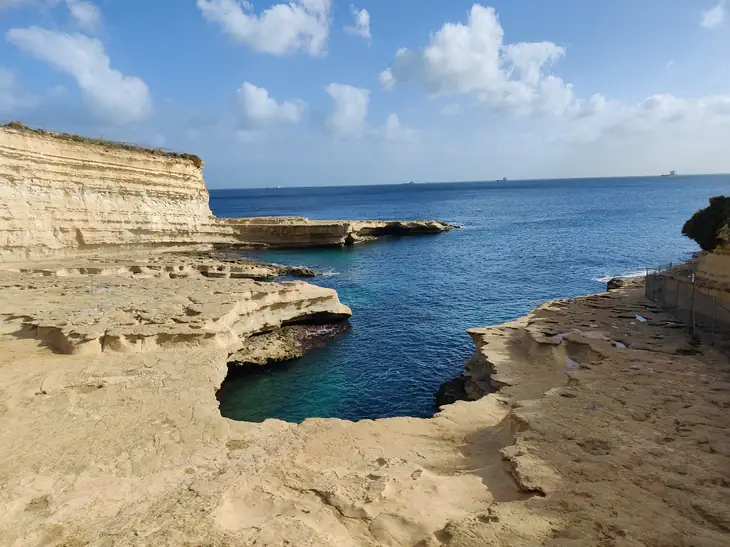
St. Peter's Pool
If you are more of a rocky beach person, then the south of Malta has some great rocky beaches to explore. One highlight is St. Peter’s Pool, located near the town of Marsaxlokk. It is a natural pool formed by the erosion of the limestone cliffs, which create a smooth and flat surface. It has deep and clear water, making it suitable for adventurous swimmers and divers.
Situated in an area called Delimara, the beach is about a 10-minute drive from the centre of Marsaxlokk, and it is not serviced by any public transport as the area is a bit off the beaten path. However, making the effort to get there is well worth it, as the water is crystal clear and is ideal for swimming, snorkelling, and diving.
Il-Kalanka

Il-Kalanka
Further into the area of Delimara Pensiula, one can find Il-Kalanka. This hidden gem is not well-known or signposted, is a slightly larger cove than St. Peter’s Pool, and is a little more accessible to get to. It is absolutely our favourite beach on the islands, and you can for sure find many locally here, taking a respite from the summer heat.
The beach doesn’t provide many facilities, but it’s well worth a visit for any good swimmer. Make sure before leaving the area to visit the Tulliera Farm Shop and walk your way to the tip of the pennuisla past the Delimara lighthouse.
St. Thomas Bay
St. Thomas Bay is a large and quiet bay located on the southeastern coast of Malta, near the town of Marsaskala. It is also known as the Bay of Żejtun, as it was historically part of the nearby town of Żejtun. The beach is quite accessible, making it suitable for swimmers of all levels.
Fond Għadir Beach

Fond Għadir
Sliema is a very popular tourist destination, with many of the best hotels located in the area or near St. Julians. So if you fancy a quick swim at the end or before you start your days, you can head down to one of the popular spots in the area. One that tops the list is Fond Għadir Beach. The beach is easily accessible from the promenade, but the sea can be quite rough on windy days, so make sure you keep an eye on the flag raised by the live guards on duty.
While the beach is great for quick dips, you will be better off at other beaches if you are looking to practice some water sports.
Exiles Beach

Exiles
If you are out of luck to swim at Fond Għadir because it is too crowded or rough, take a short walk on the promenade towards St. Julians, and as the coastline turns inward, you will find Exiles Beach. The beach is easily accessible through the gardens, which separate it from the promenade.
Depending on the direction of the wind, swimming at Exiles can be way safer than Fond Għadir. The area has a lot of facilities, including food kiosks in the gardens, a playground, public bathrooms, a beach club, and a dive shack.
St. George’s Bay

St. George's Bay
Even though St. George’s Bay may not be the most aesthetically pleasing beach, hundreds of youths flock to this beach each summer, mainly because it is close to the Maltese islands’ nightlife capital, Paceville.
This sandy beach is probably the most accessible to many tourists due to its close proximity to some of the best hotels in Malta. It is also one of the Blue Flag beaches in Malta, so a lifeguard is always on duty during the summer months, and the beach area is cordoned off to prevent boats from coming close to the shore.
If your beach time is limited or if you want to socialise with the youths that come to Malta over the summer period, St. George’s Bay is definitely a good option, but if you are looking for the best beach on the island, there are definitely better places to go.
Ramla Bay
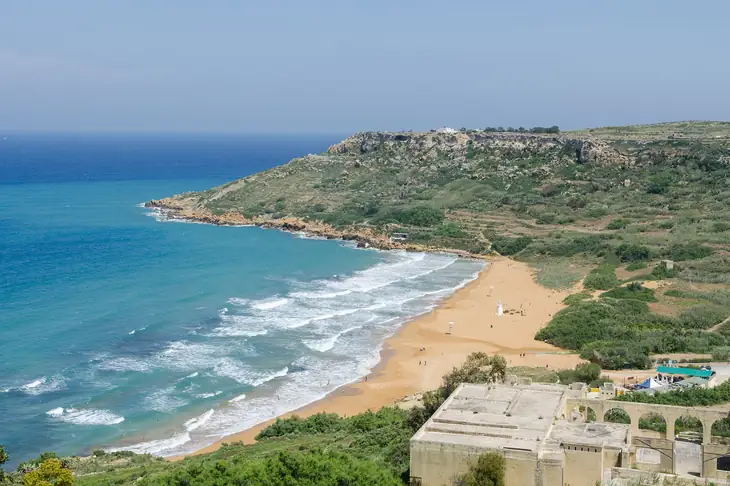
Ramla Bay | Image by DXR on Wikimedia Commons
We cannot leave Malta’s sister island of Gozo off the list, as it too provides a number of great beaches to complement your visit to this island. The largest beach on Gozo is Ramla Bay near the town of Xagħra, and for sure, the first thing you will notice is the reddish colour of its sand and the statue of the Virgin Mary in the middle of the bay.
Overlooking the beach, there is Calypso Cave. The cave took its name from the nymph Calypso, who was said to have lived in the cave and entertained Odysseus in Homer’s epic adventure, The Odyssey. On the opposite side of the beach from Calypso Cave, there is another cave called Tal-Mixta with similar breathtaking views of the beach below.
Ħondoq Bay
This charming pebbly beach, known to the locals as Ħondoq Ir-Rummien, is located directly opposite the island of Comino and can be reached via the village of Qala.
It is a hidden gem on the island of Gozo and well worth a visit; however, the small beach can get crowded and uncomfortable, especially in the peak season. It also has less shade and shelter from the sun and wind and can be affected by jellyfish and seaweed.
Xlendi Bay

Xlendi Bay | Image by Dave Morton on Flickr
Historically, Xlendi was just a fishing village, but over the years, it has become a beloved destination, not just for the spots to take a dip but also for the numerous restaurants, bars, and hotels. Children will definitely enjoy the small, sandy beach with its gentle slope to deeper waters, while those who are feeling more brave will enjoy swimming off the lengthy stretch of rocks that surround the beach.
Xlendi can be reached by car from Munxar or the small village of Fontana, but is also well served by public transport](travel-around-malta).
Marsalforn

Marsalforn | Image by Rune E on Flickr
One of Gozo’s most popular seaside towns is Marsalforn. During the summer months, the town comes alive with the many Gozitans that move to the locality for the season and with the many tourists that come to visit.
Marsalforn has a small sandy beach, but the rocks around the coast are full of great swimming spots, so all you need to do is walk along the promenade to find your spot. One can also find many restaurants along the coast, perfect for grabbing lunch or dinner.
If you continue walking for about 10 minutes north-west along the beach, you will get to the area known as Qbajjar, which has even more sunbathing and food options. A 10-minute walk from Qbajjar will take you to another location, Xwejni Bay.
Mġarr Ix-Xini
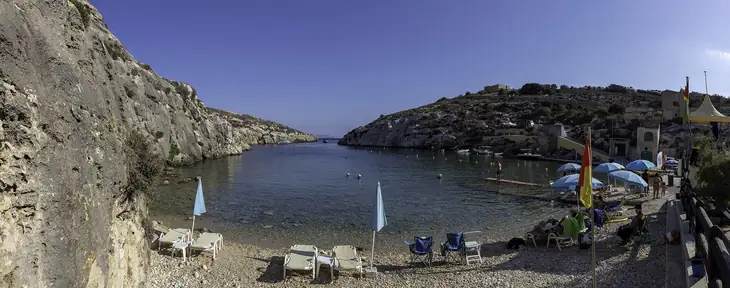
Mġarr ix-Xini | Image by Diego Delso on Wikimedia Commons
Mġarr Ix-Xini is a picturesque bay located near the town of Sannat. Located in a narrow cove, the beach is made of pebbles, and it’s a great location for snorkelling with lots of fish that get into the gorge for shelter. The beach is rather small, and parking spaces are limited, so if you want to visit, it’s best to go first thing in the morning to avoid the crowds.
Any film buff knows that Malta has been the filming location for numerous movies and TV shows over the years, and this beach served as a backdrop for the 2015 movie By the Sea, which was written and directed by Angelina Jolie.
The Inlet Sea at Dwejra

The Inlet Sea at Dwejra
The Dwejra Inlet Sea is a unique natural beach in Gozo. It is a small, landlocked body of water that is connected to the sea through a single, narrow tunnel, making the spot a perfect location for swimming and snorkelling as the water is clear and protected from the currents of the open sea.
Dwejra is also a very popular diving location, not only because the tunnel leading to the open sea provides quite a unique experience but also because of its close proximity to the Blue Hole, one of Malta’s top diving destinations.
The area was also home to the Azure Window, a natural limestone arch that was one of Malta’s most iconic and photographed landmarks. Unfortunately, the Azure Window collapsed on March 8, 2017, during a heavy storm and after years of erosion.
Conclusion
Malta and Gozo are home to some amazing beaches, and whether you prefer sandy shores or rocky coves, you’ll find your perfect spot in this guide.
We’ve listed the best beaches in Malta and Gozo based on their location, popularity, and even our personal preferences.
We hope you enjoyed this guide and found it useful. Now, it’s time to pack your bags and head to the best beaches in Malta and Gozo. Have a great beach holiday!

Life Guard | Image by Manfred Richter from Pixabay
Frequently Asked Questions
Where are the best sandy beaches in Malta located?
The best sandy beaches are located on the north-western side of Malta, with Mellieħa Bay and Golden Bay being among the favourites of many.
Where are the best rocky beaches in Malta located?
The best rocky beaches are located in the south of Malta, with St. Peter’s Pool and Il-Kalanka being some of the top spots.
When is the best time to visit the beaches in Malta and Gozo?
The best time to visit the beaches in Malta and Gozo is between June and September, when the weather is warm and sunny and many beaches are manned with lifeguards.
Are there any beaches in Malta and Gozo that are suitable for families with children?
Yes, many of the beaches in Malta and Gozo are suitable for families with children. Most sandy beaches and some rock beaches, like Fond Għadir and Exiles, are suitable for families with children.
Are there any beaches in Malta and Gozo that are suitable for snorkelling and diving?
There are numerous beaches suitable for snorkelling and diving. Some popular snorkelling and diving beaches include the Blue Lagoon, Qawra Point, Mgarr ix-Xini, and Dwejra.
Is it possible to rent sun loungers and umbrellas at the beaches in Malta and Gozo?
Yes, it is possible to rent sun loungers and umbrellas on almost all sandy beaches and the popular rocky beaches in Malta and Gozo.
What are the flags raised on blue flag beaches?
The lifeguards on duty at blue-flag beaches use a simple flag system to indicate to visitors whether it is safe to enter the water or not. A green flag indicates that it is safe to enter the water; a yellow flag indicates that you should proceed with caution; and a red flag indicates that you should not enter the water at all.
What are some of the tips and recommendations for having a safe and enjoyable beach holiday in Malta and Gozo?
Make sure you check the weather and the sea conditions before you go into the water and ensure you bring along sunscreen, sunglasses, a hat, plenty of water, and snacks, as some beaches may not have enough shade, shelter, or facilities.
How safe are the beaches in Malta?
Malta has numerous beaches that have been awarded the prestigious "Blue Flag" award, a worldwide recognition given to beaches that are proven to be clean, safe, and environmentally conscious. The award is given after the beach conforms to strict requirements pertaining to regular water quality testing, environmental education and management, and providing safety services like lifeguards and first aid equipment.
How can I get around Malta and Gozo once I'm there?
The best way to get around Malta and Gozo once you're there is by using public transport, which is cheap and reliable. You can use buses, which cover most of the towns and villages and have a flat fare of €2. You can also use ferries, which connect the main harbours and islands and have a variable fare depending on the distance and the season. You can also use taxis, which are convenient and comfortable but more expensive. You can also use car rentals, which are flexible and independent but require a valid driving licence and insurance.







